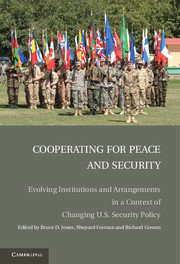 Cooperating for Peace and Security
Cooperating for Peace and Security Book contents
- Frontmatter
- Contents
- Contributors
- Foreword
- Acknowledgments
- I FRAMEWORK
- II ADAPTING COLD WAR INSTITUTIONS
- III NEW TOOLS, NEW MECHANISMS
- 10 Normative Evolution at the UN: Impact on Operational Activities
- 11 Constructing Sovereignty for Security
- 12 New Arrangements for Peace Negotiation
- 13 International Humanitarian Cooperation: Aiding War's Victims in a Shifting Strategic Environment
- 14 The Evolution of Regional and Subregional Collective Security Mechanisms in Post–Cold War Africa
- 15 International Courts and Tribunals
- IV CONCLUSIONS
- Index
- References
12 - New Arrangements for Peace Negotiation
Published online by Cambridge University Press: 22 January 2010
- Frontmatter
- Contents
- Contributors
- Foreword
- Acknowledgments
- I FRAMEWORK
- II ADAPTING COLD WAR INSTITUTIONS
- III NEW TOOLS, NEW MECHANISMS
- 10 Normative Evolution at the UN: Impact on Operational Activities
- 11 Constructing Sovereignty for Security
- 12 New Arrangements for Peace Negotiation
- 13 International Humanitarian Cooperation: Aiding War's Victims in a Shifting Strategic Environment
- 14 The Evolution of Regional and Subregional Collective Security Mechanisms in Post–Cold War Africa
- 15 International Courts and Tribunals
- IV CONCLUSIONS
- Index
- References
Summary
In the fifteen years following the end of the Cold War, the landscape in which peace negotiations are conducted was transformed quite comprehensively as a result of a number of different factors. These include a change in the conflicts in which settlement was attempted through mediation – notably a move away from the Cold War conflicts whose proxy nature left open the possibility of leverage on contending parties by their former patrons – but also a change in the nature of mediators. Thus developments in the global security environment, including the launch by the United States of the “war on terrorism” in the aftermath of the attacks of September 11, 2001, were in many instances accompanied by a shift away from great power or United Nations (UN)-led negotiations to much more complex scenarios in which a variety of peacemakers, or would-be peacemakers, pressed for involvement.
From the mid-1990s a profusion of peacemakers saw multilateral and great power mediators working alongside or in partnership with small and middle powers, or “helpful fixer” peacemakers as well as regional and subregional organizations, and an increasing array of nongovernmental or private actors. This reflected a global context – widely analyzed elsewhere in this volume – in which the culture, distribution, and use of power were both dominated by the assertion of the might of the United States and diffused by the roles assumed by new actors and forces in international peace and security.
- Type
- Chapter
- Information
- Cooperating for Peace and SecurityEvolving Institutions and Arrangements in a Context of Changing U.S. Security Policy, pp. 227 - 246Publisher: Cambridge University PressPrint publication year: 2009
References
- 1
- Cited by


